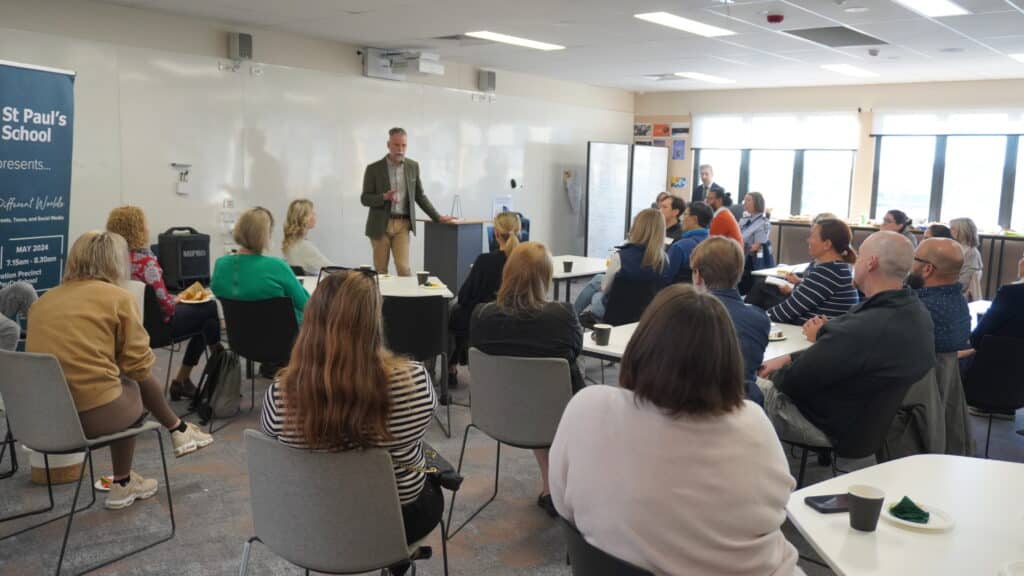
From the Principal – From Different Worlds: Parents, Teens, and Social Media
Social media and its influence on teenagers is a topical issue in the media, as it should be. This focus is timely as we welcomed parents of students in Years 7, 8 and 9 last week to share breakfast with the Senior Leadership Team where Erica Trudgian, Director of Wellbeing and I had the
opportunity to provide professional and personal advice into the varying relationships of social media across generations.
As a father of three teenagers, my wife and I are in the thick of it!
The Digital Landscape
Our teenagers are growing up in a world where social media is ubiquitous. They have only known a world with social media, with many of us posting their baby photos on Facebook years ago. Social media is deeply embedded in our daily lives, and even more so for teenagers. Recent
studies show that Generation Alpha has now arrived, many of whom are learning to turn a device on and off and swipe before they can speak.
Alarming Statistics
Recent concerns from health authorities highlight the negative impacts of social media on young Queenslanders. Chief Health Officer John Gerrard has urged parents to limit or exclude social media use for children under 14. Hospitalisations for self-harm among Queensland girls 14 years and younger have tripled since 2008, and doubled for girls aged 15-19.
Boys under 14 have also seen a significant increase. Dr. Gerrard linked this rise in self-harm to the pervasive influence of social media, describing it as an unstoppable phenomenon, further stating, “Young children are less likely than older children to have the developmental capacity to manage social media adequately and the content they are exposed to”.
Additional data shows that one in five girls feel anxious without immediate access to their digital device. In 2021, a poll found that the top career aspirations for 13-17-year-olds had shifted to becoming YouTubers, vloggers, or professional streamers, replacing traditional roles like doctors or athletes. A similar poll in the U.S. indicated that 25% of school leavers aspired to be social media influencers.
The Dual Nature of Social Media
Social media has both positive and challenging aspects. On the positive side, platforms like Instagram, Snapchat, and TikTok help teenagers maintain friendships and create new ones, offering a sense of belonging and community. These platforms also provide spaces for self expression and learning. However, despite its positives, setting boundaries for social media use often leads to conflicts between generations around monitoring content, messaging and overall screentime and in my own instance, simply persuading my daughters to take the dogs for a walk!
Validation
Teenagers often seek validation through social media success, translating it to personal worth. They are questioning their significance more than ever, seeking validation from their online presence. True self-worth, however, comes from deeper, more inherent sources than social media
validation. Dom Fay, a Faith and Spirituality Educator and Podcaster, states that now more than ever many young people feel that their worth is something that they don’t have on day one. It’s something they have to earn and conquer and achieve. In a sense asking, who am I? Why do I matter in the world? Why am I here, and we know that worth is only going to come from something much more deep and much more inherent than any sort of fleeting social
Connectivity and its Consequences
Adults can see the pressure and stress of maintaining an online image, while social media exploits the human need for social belonging and status through features designed for instant gratification. Social media offers access to diverse perspectives and ideas, but it also exposes teens to
misinformation and harmful content, necessitating discussions about the reality behind curated images.
Expert Advice and Personal Tips
Experts recommend maintaining open communication with teens about their online experiences, both good and bad. Educating them about privacy settings and the risks of oversharing is crucial. Encouraging engagement with positive communities and influencers, and being aware of signs of cyberbullying, are essential steps. Teaching teens to question sources of information and identify misinformation helps them develop critical thinking skills. Additionally, helping them find a healthy balance between online and offline life is important.
From my own experience, I suggest setting clear expectations when giving a teenager a smartphone. Regularly checking apps and monitoring for hidden accounts can prevent issues. Teaching teens not to engage with inappropriate images or messages is vital. Setting your own
boundaries, even if other parents are more lenient, helps maintain control. Avoid allowing phones in bedrooms or bathrooms and ensure that the phone remains under your ownership and monitoring. Appropriate consequences should be tied to social media-related misbehaviour, not
general bad behaviour. Lastly, it is important that we model good phone behaviour to set a positive example.
Embracing Ordinary Joys
William Martin provides a wonderful poem that highlight our teenagers hunger, this longing for something bigger, something deeper, that perhaps has mistakenly been turned towards the influencer trend. The poem is this.
Do not ask your children to strive for extraordinary lives.
Such striving may seem admirable, but it is the way of foolishness.
Help them instead to find the wonder and the marvel of an ordinary life.
Show them the joy of tasting tomatoes, apples, and pears.
Show them how to cry when pets and people die.
Show them the infinite pleasure in the touch of a hand and make the ordinary come alive for them.
The extraordinary will take care of itself.
I look forward to welcoming families to future events we will be holding throughout the remainder of the year. Details of these events will be shared with you as the year progresses.
John O’Sullivan Williams
Acting Principal
